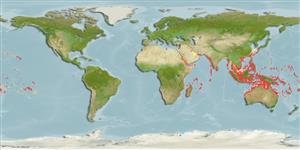>
Eupercaria/misc (Various families in series Eupercaria) >
Lutjanidae (Snappers) > Lutjaninae
Etymology: Lutjanus: Malay, ikan lutjan, name of a fish.
More on author: Cuvier.
Environment: milieu / climate zone / depth range / distribution range
Ecologia
marinhas; estuarina associadas(os) a recifes; intervalo de profundidade 1 - 60 m (Ref. 9710). Tropical; 31°N - 27°S, 31°E - 136°W (Ref. 55)
Indo-Pacific: East Africa to the Marquesas and Line islands, north to the Ryukyu Islands, south to Australia.
Tamanho / Peso / Idade
Maturity: Lm ? range ? - ? cm
Max length : 60.0 cm TL macho/indeterminado; (Ref. 55); common length : 50.0 cm TL macho/indeterminado; (Ref. 55)
Espinhos dorsais (total): 10; Raios dorsais moles (total): 13-14; Espinhos anais 3; Raios anais moles: 8 - 9. This species is distinguished by the following characters: body moderately deep to somewhat slender; greatest depth 2.6-3.0 in SL; preopercular notch and knob poorly developed; vomerine tooth patch crescentic, without a medial posterior extension; tongue smooth, no teeth; gill rakers of first gill arch 7 + 11-12 = 18-19 (including rudiments); caudal fin truncate to slightly emarginate; scale rows on back rising obliquely above lateral line. Colour generally whitish to pinkish with dusky scale margins; grey or brown on upper back and dorsal portion of head, a black spot, sometimes faint or absent, on back below anterior soft dorsal-fin rays (in juveniles, the spot is round and gradually shrinking and becoming horizontally elongate with increased growth); fins yellowish (Ref. 9821, 90102).
Adults inhabit coral reef areas, usually close to shelter in the form of caves, large coral formations and wreckage. Usually solitary; occasionally occurring in small groups. They feed mainly on fishes and benthic crustaceans, primarily crabs (Ref. 37816) at night. Flesh is sometimes ciguatoxic, and commonly so in Tuvalu (Ref. 9513).
Life cycle and mating behavior
Maturidade | Reprodução | Desova | Ovos | Fecundidade | Larvas
Allen, G.R., 1985. FAO Species Catalogue. Vol. 6. Snappers of the world. An annotated and illustrated catalogue of lutjanid species known to date. FAO Fish. Synop. 125(6):208 p. Rome: FAO. (Ref. 55)
Categoria na Lista Vermelha da IUCN (Ref. 130435)
Ameaça para o homem
Reports of ciguatera poisoning (Ref. 4690)
Utilização humana
Pescarias: espécies comerciais; Aquacultura: espécies comerciais
Mais informação
ReferênciasAquaculturaPerfil para aquaculturaEstirpesGenéticaElectrophoresesHereditariedadeDoençasProcessamentoNutrientsMass conversion
Ferramentas
Relatórios especiais
Descarregue XML
Fontes da internet
Estimates based on models
Preferred temperature (Ref.
123201): 24.8 - 29.1, mean 28.1 °C (based on 1352 cells).
Phylogenetic diversity index (Ref.
82804): PD
50 = 0.5000 [Uniqueness, from 0.5 = low to 2.0 = high].
Bayesian length-weight: a=0.01479 (0.00953 - 0.02295), b=2.95 (2.83 - 3.07), in cm total length, based on LWR estimates for this species & Genus-body shape (Ref.
93245).
Nível Trófico (Ref.
69278): 4.3 ±0.74 se; based on food items.
Generation time: 5.0 ( na - na) years. Estimated as median ln(3)/K based on 1
growth studies.
Resiliência (Ref.
120179): Médio, tempo mínimo de duplicação da população 1,4 - 4,4 anos (K=0.22).
Fishing Vulnerability (Ref.
59153): Moderate vulnerability (40 of 100).
Nutrients (Ref.
124155): Calcium = 27.9 [17.4, 42.8] mg/100g; Iron = 0.323 [0.208, 0.534] mg/100g; Protein = 18.8 [17.3, 20.1] %; Omega3 = 0.139 [0.094, 0.206] g/100g; Selenium = 55.7 [33.2, 89.0] μg/100g; VitaminA = 214 [40, 853] μg/100g; Zinc = 0.431 [0.329, 0.600] mg/100g (wet weight);
